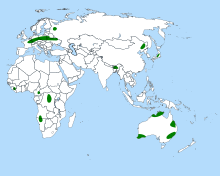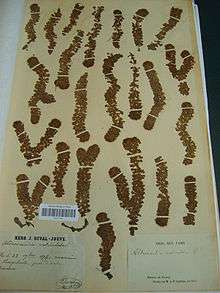Aldrovanda vesiculosa
| Aldrovanda vesiculosa | |
|---|---|
 | |
| Scientific classification | |
| Kingdom: | Plantae |
| (unranked): | Angiosperms |
| (unranked): | Eudicots |
| (unranked): | Core eudicots |
| Order: | Caryophyllales |
| Family: | Droseraceae |
| Genus: | Aldrovanda |
| Species: | A. vesiculosa |
| Binomial name | |
| Aldrovanda vesiculosa L. | |
 | |
| Distribution | |
| Synonyms[2] | |
| |

Aldrovanda vesiculosa, commonly known as the waterwheel plant, is the sole extant species in the flowering plant genus Aldrovanda of the family Droseraceae. The plant captures small aquatic invertebrates using traps similar to those of the Venus flytrap. The traps are arranged in whorls around a central, free-floating stem, giving rise to the common name. This is one of the few plant species capable of rapid movement.
While the genus Aldrovanda is now monotypic, up to 19 extinct species are known in the fossil record.[3][4][5] While the species displays a degree of morphological plasticity between populations, A. vesiculosa possesses a very low genetic diversity across its entire range.[5]
A. vesiculosa has declined over the last century to only 50 confirmed extant populations worldwide. These are spread across Europe, Africa, Asia and Australia.[5]
Morphology
A. vesiculosa is a rootless aquatic plant. Seedlings develop a short protoroot; however, this fails to develop further and senesces. The plant consists of floating stems reaching a length of 6–40 cm.[5][6] The 2–3 mm trap leaves grow in whorls of 5–9 in close succession along the plant's central stem. The actual traps are held by petioles which hold air sacks that aid in flotation. One end of the stem continually grows while the other end dies off. Growth is quite rapid (4–9 mm/day in Japanese populations[7]), so that in optimal conditions a new whorl is produced once or more each day.
Trap
The actual traps consist of two lobes which fold together to form a snap-trap similar to that of the Venus fly trap, except that it is smaller and located underwater. These traps, which are twisted so that the trap openings point outward, are lined on the inside by a fine coating of trigger hairs, snapping shut in response to contact with aquatic invertebrates and trapping them. The closing of this trap takes 10–20 milliseconds,[8][9] making it one of the fastest examples of plant movement in the kingdom. This trapping is only possible in warm conditions (20 °C).[10] Each trap is surrounded by between four and six 6–8 mm long bristles that prevent triggering of traps by debris in the water.
Reproduction
Flowers
The small, solitary white flowers of A. vesiculosa are supported above the water level by short peduncles which arise from whorl axes. The flower only opens for a few hours, after which the structure is brought back beneath the water level for seed production. The seeds are cryptocotylar: the cotyledons remain hidden within the seed coat and serve as energy storage for the seedlings. Flowering, however, is rare in temperate regions and poorly successful in terms of fruit and seed development.[5]
Divisions
A. vesiculosa reproduces most often through vegetative reproduction. In favourable conditions, adult plants will produce an offshoot every 3–4 cm,[11] resulting in new plants as the tips continue to grow and the old ends die off and separate. Due to the rapid growth rate of this species, countless new plants can be produced in a short period of time in this fashion.
Turions
Winter-hardy Aldrovanda form turions as a frost survival strategy. At the onset of winter, the growth tip starts producing highly reduced non-carnivorous leaves on a severely shortened stem. This results in a tight bud of protective leaves which, being heavier and having released flotational gases, breaks off the mother plant and sinks to the water bottom, where temperatures are stable and warmer. Here it can withstand temperatures as low as −15 °C (5 °F).[12] In the wild, Aldrovanda turions have been observed to have a relatively low rate of successful sinking.[12] Those nutritious turions that fail to sink are then grazed by waterfowl or are killed by the onset of frost. In spring when water temperatures rise above 12–15 °C, turions reduce their density and float to the top of the water, where they germinate and resume growth.[12] Non-dormant turion-like organs can also form in response to summer drought.[12]
Distribution
A. vesiculosa is the most widely distributed carnivorous plant species, native to Europe, Asia, Africa, and Australia. Aldrovanda is spread mainly through the movement of waterfowl: plants sticking to the feet of a bird are transported to the next aquatic destination on the bird's route. As a result, most Aldrovanda populations are located along avian migratory routes. Throughout the last century the species has become increasingly rare, listed as extinct in an increasingly large number of countries.[5]
Habitat
A. vesiculosa prefers clean, shallow, warm standing water with bright light, low nutrient levels and a slightly acidic pH (around 6). It can be found floating amongst Juncus, reeds, and even rice.
Botanical history

A. vesiculosa was first mentioned in 1696 by Leonard Plukenet, based on collections made in India. He named the plant Lenticula pulustris Indica. The modern botanical name originates from Gaetano Lorenzo Monti, who described Italian specimens in 1747 and named them Aldrovandia vesiculosa in honor of the Italian naturalist Ulisse Aldrovandi.[13] When Carl Linnaeus published his Species Plantarum in 1753, the "i" was dropped from the name (an apparent orthographic error)[14] to form the modern binomial.[11]
Infraspecific taxa
- Aldrovanda vesiculosa var. rubescens A.Cross and L.Adamec (2012)
- Aldrovanda vesiculosa var. aquitanica Durieu ex Diels (1906) nom. illeg.
- Aldrovanda vesiculosa var. australis Darwin (1876) nom. illeg.
- Aldrovanda vesiculosa var. duriaei Caspary (1859) nom. illeg.
- Aldrovanda vesiculosa var. verticillata (Roxb.) Darwin (1876) nom. illeg.
See also
References
- ↑ Cross, A. 2012. Aldrovanda vesiculosa. In: IUCN 2012. IUCN Red List of Threatened Species. Version 2012.2. Downloaded on 17 October 2012.
- ↑ "World Checklist of Selected Plant Families". Retrieved July 31, 2014.
- ↑ Huber, H. 1961, Aldrovanda, in Hegi, Illustrierte Flora von Mitteleuropa ed 2. IV(2a): 18-20. Carl Hanser Verlag, München.
- ↑ Degreef, J.D. 1997, Fossil Aldrovanda, Carnivorous Plant Newsletter 26
- 1 2 3 4 5 6 Cross, A. 2012. Aldrovanda, The Waterwheel Plant. Redfern Natural History Productions, Dorset, UK, 249pp
- ↑ Aston, H.I. 1983, Aldrovanda vesiculosa L., in Flora of Australia 8: 64-66.
- ↑ Komiya, S. 1966, A report on the natural habitat of Aldrovanda vesiculosa found in Hanyu City. Amatores Herb. (Kobe, Japan) 27: 5-13.
- ↑ Ashida, J. 1934, Studies on the leaf movement of Aldrovanda vesiculosa L. I. Process and mechanism of the movement. Mem. Coll. Sci. Univ. Kyoto Ser. B 9: 141-244.
- ↑ Ashida, J. 1935, Studies on the leaf movement of Aldrovanda vesiculosa L. II. Effect of mechanical, electrical, thermal, osmotic and chemical influences. Mem. Coll. Sci. Univ. Kyoto Ser. B 11: 55-113.
- ↑ Diels, L. 1906, Droseraceae, in Das Pflanzenreich 26 (IV, 112): 1-136, Leipzig.
- 1 2 Breckpot, Christian (1997). "Aldrovanda vesiculosa: Description, Distribution, Ecology and Cultivation". Carnivorous Plant Newsletter. 26: 73–82.
- 1 2 3 4 L. Adamec: Turion overwintering of aquatic carnivorous plants.. in: Carnivorous plant newsletter. Arboretum, Fullerton Ca 28.1999,1, 19–24
- ↑ Monti, G. De Aldrovandia nova herba palustris genere. De Bononiensi Scientiarum et Artium Instituto atque Academia commentarii. v. 2 pt.3, 402. 1747
- ↑ Duval-Jouve, 1861, Bull. Soc. Bot. France 8:518-519.
External links
| Wikimedia Commons has media related to Aldrovanda vesiculosa. |
